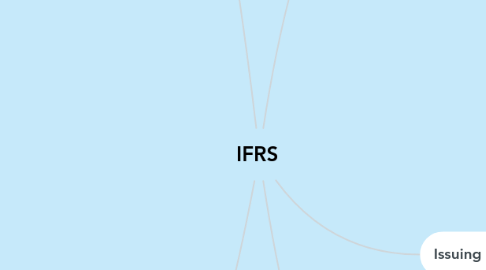
1. IAS
1.1. IAS 16 (PPE)
1.1.1. Recognition
1.1.1.1. Economic benefit
1.1.1.2. Reliably measured
1.1.2. Cost
1.1.2.1. Initial measurement
1.1.2.1.1. Purchase Price
1.1.2.1.2. Attributable costs
1.1.2.1.3. Removal cost
1.1.2.2. Subsequent measurement
1.1.2.2.1. Cost model
1.1.2.2.2. Revaluation Model
1.2. IAS 38 (Intangible Assets)
1.2.1. Identifiable, non monetary assets
1.2.2. Recognition
1.2.2.1. Future economic benefit
1.2.2.2. Reliable measurement
1.2.3. Capitalize
1.2.3.1. No
1.2.3.1.1. Start up costs
1.2.3.1.2. Research expenditure
1.2.3.1.3. Internally generated, such as goodwill
1.2.3.2. Yes
1.2.3.2.1. Development expenditure
1.2.3.2.2. Purchased goodwill
1.2.4. R&D
1.2.4.1. Expense research
1.2.4.2. Capitalize development if feasible and carries future economic benefits
1.2.5. Measurement
1.2.5.1. Cost model
1.2.5.2. Revaluation model
1.2.6. Amortization
1.2.6.1. Straight line
1.2.6.2. In line with sales
1.3. IAS 37 (Provisions, Contigent Liabilities and Contigent Assets)
1.3.1. Provision
1.3.1.1. =Liability of uncertain timing or amount
1.3.1.2. When to recognize
1.3.1.2.1. Present obligation
1.3.1.2.2. Propable Outflow
1.3.1.2.3. Reliable estimate
1.3.1.3. Measurement
1.3.1.3.1. Expected value
1.3.1.3.2. Individual most likely outcome
1.3.2. Contigencies
1.3.2.1. Contigent Liabilities
1.3.2.1.1. Possible obligation
1.3.2.1.2. Present obligation + outflow possible not probable or not reliably measured
1.3.2.2. Contigent Assets
1.3.2.2.1. Possible asset + inflow is probable
2. IFRS
2.1. IFRS 16 (Leasing)
2.1.1. Lessee
2.1.1.1. Right-of-use asset
2.1.1.2. Lease liability
2.1.2. Lessor
2.1.2.1. Finance Lease
2.1.2.1.1. Debit: Leas receivable
2.1.2.1.2. Credit PPE
2.1.2.2. Operating lease
2.1.2.2.1. Lease payments
2.1.2.2.2. Asset
2.1.3. Definition
2.1.3.1. The right to control the use of asset
2.1.3.2. For a period of time
2.1.4. Sale & Leaseback
2.2. IFRS 15 (Revenue Recognition)
2.2.1. 5 Step Model
2.2.1.1. 1. Identify the contract
2.2.1.2. 2. Identify the performance Obligation
2.2.1.3. 3. Determine the transaction
2.2.1.4. 4. Allocate the TP to the PO
2.2.1.5. 5. Recognise revenue
2.3. IFRS 10 Consolidated Financial Statements
2.3.1. Outlines the requirements for the preparations and presentation of consolidated financial statement
2.3.2. Parent entity and subsidiaries
2.3.3. Defines principle of control
2.3.4. Sets accounting requirements for the preparation of consolidated financial statements
2.3.4.1. The financial Statements of a group in which the assets, liabilities, equity, income, expenses and cash flows of the parent and its subsidiaries are presented as of single economic entity
2.3.5. Consolidatedp procedures
2.3.5.1. Combine like items of assets, liabilities, equity, income, expenses and cash flows of the parent with its subsidiaries
2.3.5.2. Eliminate the carrying amount of the parent's investment in its subsidiaries
2.3.5.3. Eliminate intragroup transactions
2.4. IFRS 3 (Business Combinations)
2.4.1. Determining if transaction is a business combination
2.4.1.1. Input (An economic resource)
2.4.1.2. Process
2.4.1.3. Output (the result)
2.4.2. Accounting
2.4.2.1. Acquisition method
2.4.2.1.1. 1. Identify acquirer
2.4.2.1.2. 2. Determine acquisition date
2.4.2.1.3. 3. Recognise assets, liabilities and non-controlling interest
2.4.2.1.4. 4. Recognise goodwill
3. IASB=International Accounting Standards Board
3.1. Issues IFRS standards
3.2. Representatives from 100 countries
3.3. Key objective is to develop global standards and promote they usage
4. Issuing new standard
4.1. Discussion paper
4.1.1. Analysis
4.1.1.1. Exposure Draft
4.1.1.1.1. Analysis
5. Framework
5.1. Objective of Financial reporting
5.1.1. Provide Financial information about the reporting entity for i.e. investors
5.2. The qualitative characteristics and constraints
5.2.1. Comparability
5.2.2. Verifiability
5.2.3. Timeliness
5.2.4. Undersandability
5.2.5. Reliability
5.2.6. Relevance
5.3. The definition, measurement and recognition of elements from which Financial statements are constructed
5.3.1. Assets
5.3.2. Liabilities
5.3.3. Equity
5.3.4. Performance
5.3.5. Income
5.3.6. Expenses
5.4. Assumptions
5.4.1. Accrual Accounting
5.4.2. Going Concern

